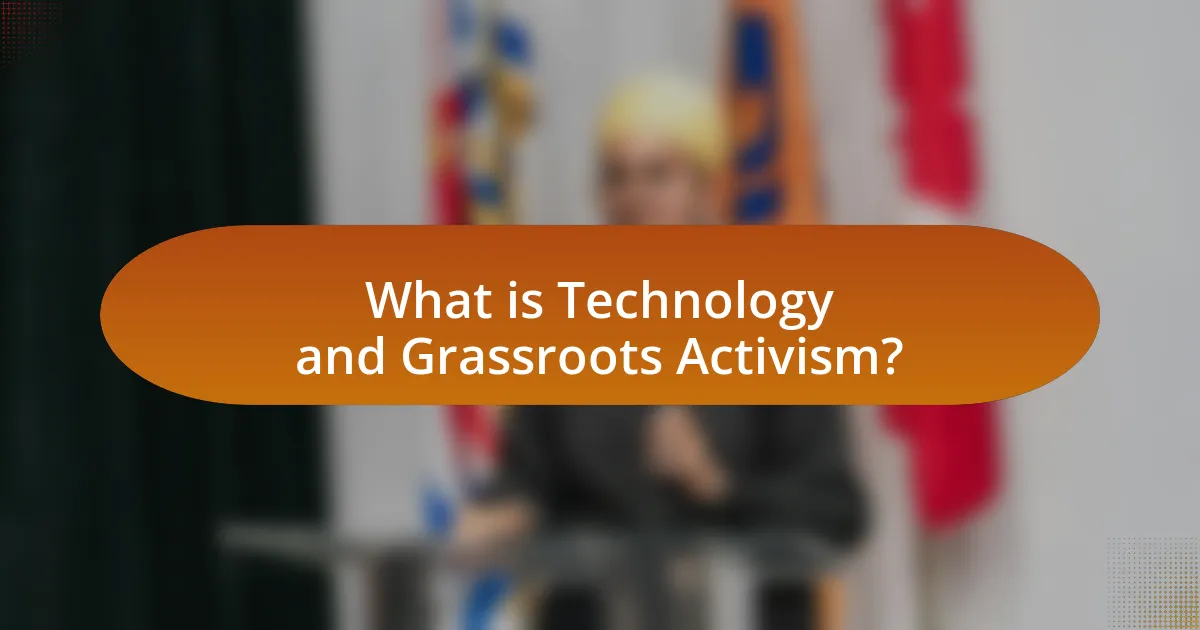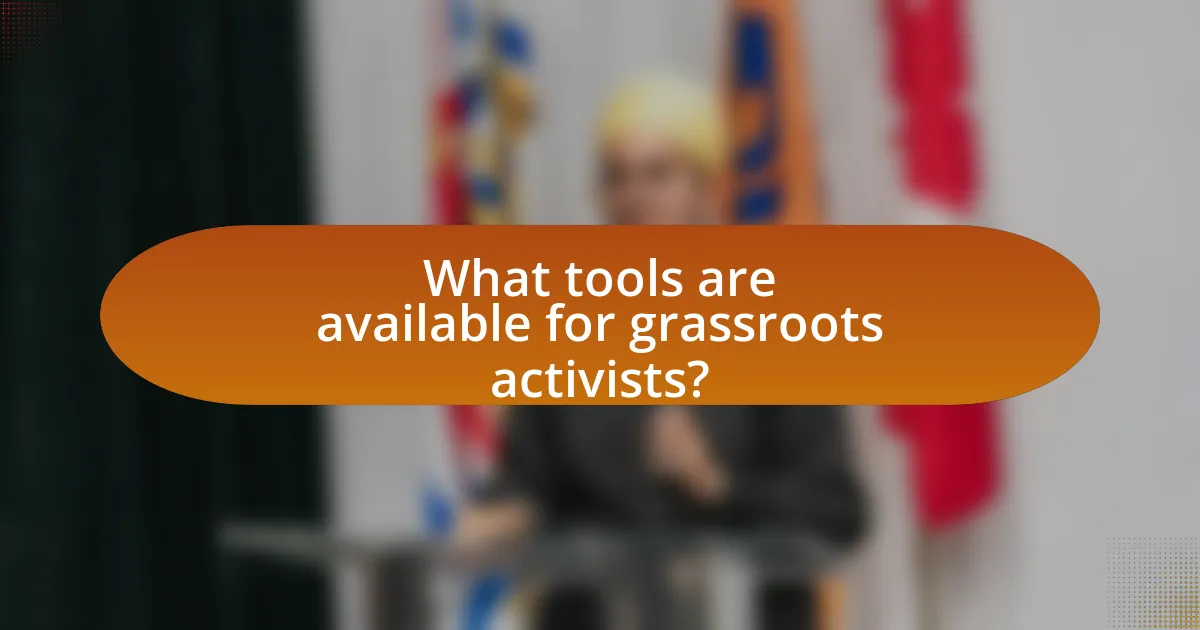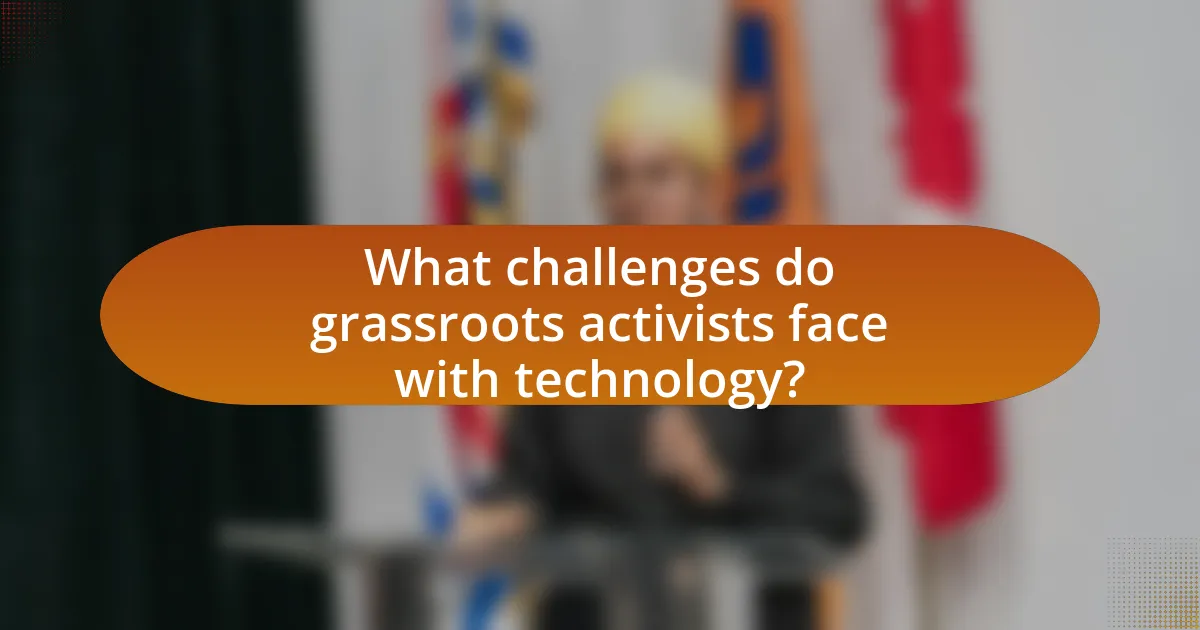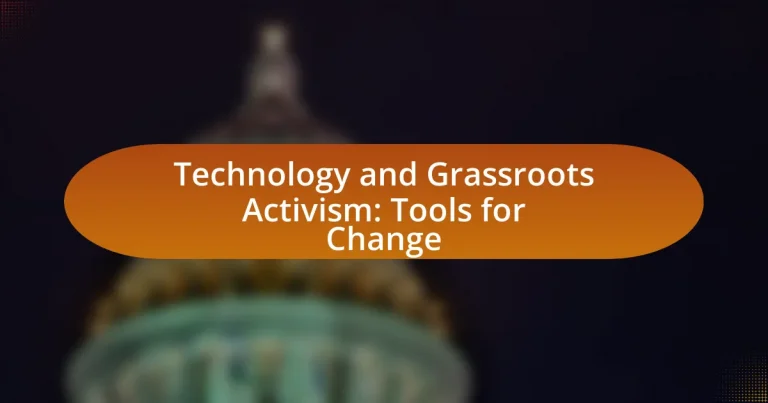Technology and grassroots activism encompass the utilization of digital tools and platforms by local communities to advocate for social change. This article explores the intersection of technology and grassroots movements, highlighting how digital platforms facilitate communication, mobilization, and organization. It discusses the role of social media, mobile applications, and crowdfunding in empowering activists, while also addressing challenges such as the digital divide and cybersecurity threats. Additionally, the article examines the importance of grassroots activism in addressing social issues and enhancing community engagement, along with best practices for effectively leveraging technology in activism.

What is Technology and Grassroots Activism?
Technology and grassroots activism refers to the use of digital tools and platforms by local communities to mobilize, organize, and advocate for social change. This relationship enables activists to leverage social media, mobile applications, and online communication to raise awareness, coordinate efforts, and engage supporters effectively. For instance, the Arab Spring in 2010 showcased how social media facilitated grassroots movements, allowing citizens to organize protests and share information rapidly, leading to significant political changes in several countries.
How do technology and grassroots activism intersect?
Technology and grassroots activism intersect by enabling widespread communication, mobilization, and organization of social movements. Digital platforms, such as social media, allow activists to share information rapidly, reach larger audiences, and coordinate actions effectively. For instance, the Arab Spring in 2011 demonstrated how social media facilitated grassroots movements, leading to significant political changes in several countries. Additionally, tools like crowdfunding platforms empower grassroots organizations to raise funds and support their initiatives, further enhancing their impact.
What role does technology play in empowering grassroots movements?
Technology plays a crucial role in empowering grassroots movements by facilitating communication, organization, and mobilization among activists. Digital platforms enable grassroots organizations to reach wider audiences, share information rapidly, and coordinate actions effectively. For instance, social media has been instrumental in movements like the Arab Spring, where platforms such as Twitter and Facebook allowed activists to organize protests and disseminate information despite government censorship. Additionally, tools like crowdfunding websites have provided financial support for grassroots initiatives, enabling them to sustain their efforts. The use of data analytics also allows movements to identify key issues and target their messaging more effectively, enhancing their impact.
How has the landscape of activism changed with technological advancements?
Technological advancements have significantly transformed the landscape of activism by enhancing communication, mobilization, and awareness. Social media platforms, such as Twitter and Facebook, enable activists to reach a global audience instantly, facilitating rapid information dissemination and community building. For instance, the #BlackLivesMatter movement gained momentum through social media, leading to widespread protests and policy discussions following incidents of police violence. Additionally, tools like crowdfunding platforms have allowed grassroots organizations to secure funding directly from supporters, bypassing traditional funding sources. According to a 2020 report by the Pew Research Center, 69% of Americans believe social media is an effective tool for activism, highlighting its impact on public engagement and participation.
Why is grassroots activism important in today’s society?
Grassroots activism is important in today’s society because it empowers individuals to effect change at the community level, fostering democratic participation and social justice. This form of activism mobilizes local communities to address issues that directly impact their lives, such as environmental concerns, racial equality, and economic disparities. For instance, the Black Lives Matter movement, which originated from grassroots efforts, has significantly influenced national conversations about police reform and racial justice, demonstrating the power of collective action. Additionally, grassroots activism often utilizes technology, such as social media platforms, to amplify voices and organize campaigns, making it easier for diverse groups to connect and mobilize. This combination of local engagement and technological tools enhances the effectiveness and reach of social movements, making grassroots activism a vital component of contemporary societal change.
What social issues are commonly addressed through grassroots activism?
Grassroots activism commonly addresses social issues such as racial equality, environmental justice, gender rights, and economic inequality. These movements often emerge from local communities seeking to influence policy and raise awareness about injustices. For instance, the Black Lives Matter movement has significantly impacted discussions around racial equality, while organizations like Greenpeace focus on environmental issues, advocating for sustainable practices and climate action. Additionally, grassroots efforts have been pivotal in advancing gender rights, as seen in the Me Too movement, which highlights sexual harassment and assault. Economic inequality is also a focal point, with various groups advocating for fair wages and workers’ rights, reflecting a growing concern over wealth disparity.
How does grassroots activism contribute to community engagement?
Grassroots activism significantly enhances community engagement by empowering individuals to participate in local decision-making processes. This form of activism fosters a sense of ownership and responsibility among community members, encouraging them to voice their concerns and advocate for change. For instance, studies have shown that communities involved in grassroots movements often experience increased voter turnout and civic participation, as individuals feel more connected to the issues at hand. Additionally, grassroots initiatives frequently utilize social media and digital platforms to mobilize support, disseminate information, and organize events, further strengthening community ties and collective action.

What tools are available for grassroots activists?
Grassroots activists have access to various tools that enhance their ability to organize, communicate, and mobilize. Key tools include social media platforms like Facebook and Twitter, which facilitate outreach and engagement with a broader audience. Additionally, project management tools such as Trello and Asana help activists coordinate efforts and manage tasks efficiently. Communication tools like Slack and WhatsApp enable real-time collaboration among team members. Furthermore, fundraising platforms such as GoFundMe and Kickstarter assist in securing financial support for initiatives. Research indicates that social media usage among activists has increased engagement by up to 50%, demonstrating the effectiveness of these tools in driving grassroots movements.
How can social media be utilized for grassroots activism?
Social media can be utilized for grassroots activism by providing a platform for organizing, mobilizing, and amplifying voices around social issues. Activists can create events, share information, and engage supporters through posts, hashtags, and live streams, which fosters community and encourages participation. For instance, the #BlackLivesMatter movement effectively used Twitter and Instagram to raise awareness and organize protests, demonstrating the power of social media in reaching a global audience and facilitating real-time communication. Additionally, studies show that social media campaigns can increase public engagement and influence policy changes, as seen in the 2018 March for Our Lives, which mobilized youth activism through platforms like Snapchat and Facebook.
What are the best practices for using social media effectively?
The best practices for using social media effectively include creating a clear strategy, engaging with your audience, and analyzing performance metrics. A clear strategy involves defining goals, identifying target audiences, and selecting appropriate platforms to reach them. Engaging with your audience through regular interaction, responding to comments, and sharing user-generated content fosters community and loyalty. Analyzing performance metrics, such as engagement rates and reach, allows for data-driven adjustments to improve future content and strategies. According to a study by the Pew Research Center, 69% of adults in the U.S. use social media, highlighting its significance as a tool for outreach and activism.
Which platforms are most beneficial for grassroots movements?
Social media platforms such as Facebook, Twitter, and Instagram are most beneficial for grassroots movements. These platforms enable rapid information dissemination, community building, and mobilization of supporters. For instance, Facebook’s group feature allows grassroots organizations to create dedicated spaces for discussion and coordination, while Twitter’s hashtag functionality facilitates the spread of messages to a wider audience. According to a study by the Pew Research Center, 69% of adults in the U.S. use Facebook, making it a crucial tool for reaching diverse demographics. Additionally, Instagram’s visual storytelling capabilities help engage younger audiences effectively, as evidenced by the success of movements like #BlackLivesMatter, which gained significant traction through compelling imagery and narratives shared on these platforms.
What role do mobile applications play in grassroots activism?
Mobile applications serve as essential tools in grassroots activism by facilitating communication, organization, and mobilization among activists. These applications enable users to share information rapidly, coordinate events, and engage with a broader audience, thereby amplifying their message. For instance, platforms like Twitter and Facebook have been instrumental in movements such as the Arab Spring, where activists utilized mobile apps to organize protests and disseminate real-time updates. Additionally, research from the Pew Research Center indicates that 72% of smartphone users have used their devices to engage in civic activities, highlighting the significant role mobile applications play in fostering grassroots movements.
How can mobile apps facilitate organization and communication?
Mobile apps facilitate organization and communication by providing platforms for real-time collaboration and information sharing among users. These applications enable users to create groups, share documents, and coordinate activities efficiently, which is essential for grassroots activism. For instance, apps like Slack and WhatsApp allow teams to communicate instantly, while project management tools like Trello and Asana help in organizing tasks and tracking progress. According to a study by the Pew Research Center, 90% of Americans own a mobile phone, making mobile apps a widely accessible means for activists to mobilize support and disseminate information quickly.
What are some examples of successful activist apps?
Some examples of successful activist apps include Change.org, which enables users to create and sign petitions for social change, and 350.org, which focuses on climate change activism by organizing global events and campaigns. Additionally, the app Stop Hate, developed by the Anti-Defamation League, allows users to report incidents of hate and bias, contributing to community awareness and action. These apps have demonstrated effectiveness in mobilizing users and raising awareness on critical issues, evidenced by millions of petitions signed and numerous campaigns launched globally.

What challenges do grassroots activists face with technology?
Grassroots activists face significant challenges with technology, primarily including digital divide issues, cybersecurity threats, and the rapid pace of technological change. The digital divide creates barriers for activists in accessing necessary tools and platforms, as many marginalized communities lack reliable internet access or digital literacy skills. Cybersecurity threats pose risks to sensitive information and communications, making activists vulnerable to surveillance and attacks from opposing entities. Additionally, the rapid evolution of technology can outpace activists’ ability to adapt, leading to difficulties in effectively utilizing new tools for organizing and mobilization. These challenges hinder the overall effectiveness of grassroots movements in leveraging technology for social change.
How can digital security be a concern for activists?
Digital security is a significant concern for activists because it directly impacts their ability to organize, communicate, and advocate for change without fear of surveillance or retaliation. Activists often rely on digital platforms to mobilize support and share information, making them vulnerable to hacking, data breaches, and government surveillance. For instance, a report by the Electronic Frontier Foundation highlights that activists in authoritarian regimes face increased risks of digital surveillance, which can lead to arrests or harassment. Additionally, the 2020 Global Digital Report indicated that 60% of internet users are concerned about their online privacy, reflecting the widespread apprehension regarding digital security. These factors underscore the critical need for activists to adopt robust digital security measures to protect their identities and activities.
What measures can activists take to protect their data?
Activists can protect their data by using encryption tools, secure communication platforms, and privacy-focused operating systems. Encryption tools, such as Signal for messaging and VeraCrypt for file storage, ensure that sensitive information remains confidential. Secure communication platforms like ProtonMail provide end-to-end encryption for emails, safeguarding against unauthorized access. Additionally, using privacy-focused operating systems, such as Tails or Qubes OS, helps to minimize data leaks and enhance anonymity. These measures are essential as they significantly reduce the risk of surveillance and data breaches, which are common threats faced by activists in their work.
How can activists navigate online harassment and threats?
Activists can navigate online harassment and threats by employing a combination of digital security measures, community support, and reporting mechanisms. Utilizing tools such as two-factor authentication and encrypted communication can significantly enhance personal security against potential threats. Research indicates that 70% of activists experience online harassment, highlighting the need for proactive measures. Additionally, building a supportive network allows activists to share experiences and strategies, which can mitigate the psychological impact of harassment. Reporting incidents to platform moderators and law enforcement can also help address and reduce the prevalence of online threats.
What are the limitations of technology in grassroots activism?
Technology in grassroots activism has several limitations, including digital divide issues, misinformation, and surveillance concerns. The digital divide creates barriers for marginalized communities who may lack access to technology or the internet, limiting their participation in online activism. Misinformation can spread rapidly through social media platforms, undermining the credibility of grassroots movements and leading to confusion among supporters. Additionally, surveillance by governments or corporations can deter individuals from engaging in activism due to fear of repercussions, thus stifling free expression and participation. These factors collectively hinder the effectiveness of technology as a tool for grassroots activism.
How does the digital divide affect participation in activism?
The digital divide significantly limits participation in activism by creating disparities in access to technology and the internet. Individuals without reliable internet access or digital literacy are less able to engage with online platforms that facilitate activism, such as social media, petitions, and crowdfunding. According to a 2021 report by the Pew Research Center, approximately 25% of adults in the United States lack high-speed internet access, which directly impacts their ability to participate in digital activism campaigns. This exclusion not only hinders their ability to organize and mobilize but also restricts their access to information and resources necessary for effective advocacy.
What are the risks of relying too heavily on technology?
Relying too heavily on technology poses several risks, including decreased human interaction, increased vulnerability to cyber threats, and potential loss of critical thinking skills. The reliance on digital communication can lead to social isolation, as face-to-face interactions diminish, impacting community building essential for grassroots activism. Additionally, over-dependence on technology exposes organizations to cyber attacks, which can compromise sensitive data and disrupt operations. A study by the Pew Research Center found that 64% of Americans have experienced a major data breach, highlighting the risks associated with digital reliance. Furthermore, excessive use of technology can hinder the development of critical thinking and problem-solving skills, as individuals may become accustomed to seeking quick answers online rather than engaging in deeper analysis.
What best practices can enhance the effectiveness of technology in grassroots activism?
Utilizing social media platforms effectively enhances the effectiveness of technology in grassroots activism. Social media allows activists to reach a broader audience, mobilize supporters quickly, and share information in real-time. For instance, the #BlackLivesMatter movement leveraged Twitter and Facebook to organize protests and disseminate information, resulting in widespread global awareness and participation. Additionally, employing data analytics tools can help activists understand their audience better and tailor their messages for maximum impact. Research shows that campaigns utilizing targeted messaging can increase engagement rates by up to 50%. Furthermore, integrating mobile technology, such as SMS alerts, ensures timely communication with supporters, which is crucial during fast-paced events. These best practices collectively strengthen grassroots movements by enhancing outreach, engagement, and responsiveness.
How can activists measure the impact of their technological tools?
Activists can measure the impact of their technological tools by analyzing key performance indicators (KPIs) such as engagement rates, reach, and conversion metrics. For instance, social media analytics can provide data on how many users interacted with a campaign, shared content, or participated in events, which directly reflects the effectiveness of the tools used. Additionally, surveys and feedback forms can be employed to gather qualitative data from participants about their experiences and the perceived impact of the technology on their activism efforts. Research indicates that campaigns utilizing data analytics saw a 30% increase in engagement, demonstrating the value of measuring impact through concrete metrics.
What strategies can be employed to engage a wider audience through technology?
To engage a wider audience through technology, grassroots activists can utilize social media platforms, targeted digital campaigns, and interactive content. Social media platforms like Facebook, Twitter, and Instagram allow for real-time communication and sharing of information, which can significantly increase visibility and engagement. For instance, a study by Pew Research Center found that 69% of adults in the U.S. use social media, making it a vital tool for reaching diverse demographics. Targeted digital campaigns, such as email marketing and online petitions, can also effectively mobilize support by reaching individuals who are already interested in specific causes. Additionally, creating interactive content, such as webinars, live Q&A sessions, and virtual events, fosters community involvement and encourages participation. These strategies collectively enhance outreach and engagement, making technology a powerful ally in grassroots activism.


